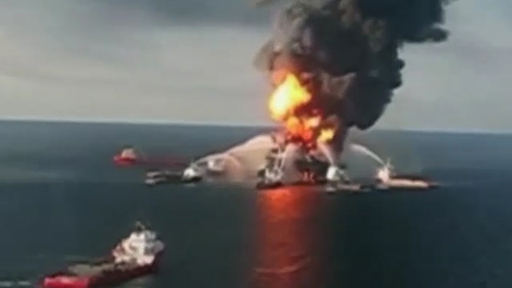4.2 When operations are not managed well
There are, of course, many examples of operations that have not been managed well. Here, you will study two examples of organisations that have suffered the consequence of a lapse in good operations management practice.
The following activity looks at the impact of a failure of operations management on a single operation.
Activity 4: Deepwater Horizon – surviving the oil spill
Look again at Example 1 in the section ‘The importance of operations management’ of Walley (2017) [Tip: hold Ctrl and click a link to open it in a new tab. (Hide tip)] .
Now watch Video 4 and answer the questions below.

Transcript: Video 4: Deepwater Horizon – surviving the oil spill
[MUSIC PLAYING]
[BIRDS NOISES]
[MUSIC PLAYING]
[MUSIC PLAYING]
[MUSIC PLAYING]
[MUSIC PLAYING]
- To what extent was this a failure of operations management practices?
Feedback
There is no doubt that this failure was a direct consequence of poor operations management practices. The disaster was not caused by a single mistake, but a whole series of decisions and actions by BP staff and suppliers Halliburton and Transocean. These decisions and actions accumulated and lead to the eventual explosion and oil leak. There were failures in both the design of processes and systems as well as poor monitoring and control:
- The technical design contained a number of flaws where several rig components could not cope with the combination of events. Two mechanical valves designed to stop the flow of gas and oil to the surface failed, allowing the oil to leak. Another valve on a device, called a blowout preventer, did not work properly. A mud−gas separator also failed but this device should not have been used at the time.
- A range of safety and control procedures were either absent or failed. One blowout preventer had a flat battery and another a defective switch, indicating poor maintenance or repair. The gas detection system did not trigger an alarm when the gas leak occurred. There were a number of staff failures indicating poor attention to safety and poor training. Staff misinterpreted the results of a pressure test, thinking the process was in control. The increase in pressure and consequential leak took 50 minutes to detect. Staff failed to use venting pipes to take the mud and gas away from the rig.
- Materials used, such as the sealing cement, proved to have not met the requirements of the job.
You should think about the reasons why managers may have made these mistakes. Sometimes it is not clear who has responsibility for particular decisions especially where tasks are subcontracted. Some decisions will be made under time or cost pressure. Put yourself in the position of a rig operations manager who is measured on the productivity of the assets. To what extent can you consistently make decisions that are based on what you consider to be low risks or ethical decisions?
- What impact did this failure have on the organisation?
Feedback
When you look at the impact of these failures the main consequences were the tragic loss of life on the rig during the accident as well as the ecological and social impacts of the oil pollution. The company experienced a number of other effects over the following years:
- The company had to agree to an $18.7bn legal settlement to cover the costs of the disaster clean-up and compensation for businesses.
- It lost the opportunity to bid for new contracts with the US government.
- It threatened access to new and existing oil field opportunities for BP to develop.
- There was a considerable loss of reputation and this fed through to lower market appeal for its products and services.
- The company had to redirect its efforts during and after the crisis, potentially losing other market development opportunities.
This list shows the extent of the longer-term impact of the failure of operations management.
The following activity examines what happens if operations are not managed well across an entire supply chain.
A supply chain involves various participants who perform a sequence of activities in moving physical goods or services from a point of origin to a point of consumption.
Activity 5: Horse meat in the supply chain
Review the section ‘The importance of operations management’ of Walley (2017) and watch Video 5, which describe the issues around the horse meat scandal, and answer the questions below.

Transcript: Video 5: Horse meat scandal – the journey food makes from farm to plate
- To what extent was the size and complexity of the supply chain a contributing factor in the food contamination?
Discussion
The case details the levels of complexity within the supply chain. Meat moves across Europe in a relatively unregulated way. The commentators in these videos indicate that the high-quality products tend to be traceable from farm (or even animal) through the entire supply chain to customer. However, at the ‘value’ end of the market, the supply chain is more complex and there is less traceability. Price competition seems to make meat processors look more widely for meat supply: this increases the number of suppliers and therefore sources of meat for their processed product. Given that the market is price sensitive, suppliers are reluctant to spend more money developing traceability mechanisms. The commentator in the video states that local government authorities have had to restrict the levels of checking they can do because of financial pressures. This places more of a burden on the companies within the supply chain to check for themselves.
Ideally, the entire supply chain should be designed so that price, quality and traceability can be achieved. The main challenge is to find one organisation that is part of this supply chain where managers are willing to take responsibility for the design and control of the entire supply chain.
- To what extent should food retailers manage and control the entire supply chain to prevent problems like this from occurring?
Feedback
Most large retail chains do have sophisticated merchandising and supply chain functions, such as the one described in the earlier video. Managers within these departments choose which products to stock on the shelves and where to source them from. This sourcing decision would normally include a supplier selection process whereby potential suppliers are assessed for their ability to provide products of the right quality, in the right quantities, to specific delivery schedules. In sophisticated assessments there could also be checks on suppliers further back in the supply chain (the supplier’s supplier etc.).
